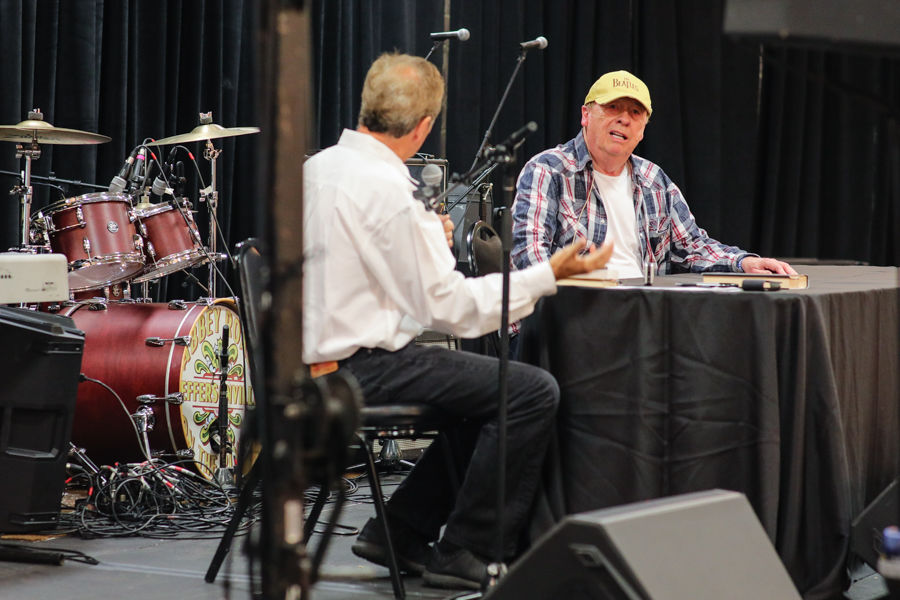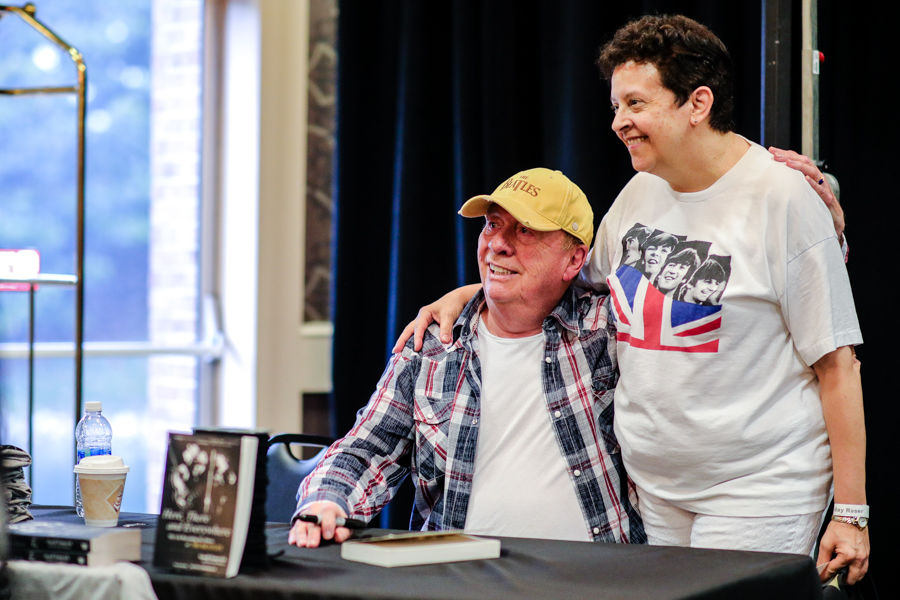www.tmnews.com
Shaping the Beatles' iconic sound
Sound engineer Geoff Emerick recalls memories of band
BY Melissa Goforth,
News and Tribune
May 31, 2018

Legendary sound engineer Geoff Emerick works with Paul McCartney of The Beatles in this photograph. Emerick penned the book, “Here, There, and Everywhere,” based on his experience in the music industry.
Courtesy photo / Geoff Emerick
Never has there been — nor will there ever be — another first week on the job quite like the one Geoff Emerick had nearly 56 years ago.
The year was 1962.
The location was EMI Records at Abbey Road in London.
Emerick was only 15.
An innovative young lad with a love of music since the age of 7, he had stepped out in faith and interviewed for a sound engineering job at the famous studio.
His Dad went along with him on that interview.
He wasn’t confident he had made an impression. But, to his delight, Emerick received a call back from the studio and was hired as an assistant engineer.
Hard to top that lucky break.
But, fate still had a little more in store for Emerick.
On his second day of work, the self-described “button pusher” had the opportunity to sit in on the first EMI recording session of a promising band from Liverpool.
They were called The Beatles.
The song was “Love Me Do.”
And life was never the same for Emerick — or the world.
Not only did he serve as assistant engineer on many of the Beatles’ other early hits, including “I Want to Hold Your Hand,” “She Loves You” and “A Hard Day’s Night,” but he went on to serve as the band’s chief recording engineer — starting a few months shy of his 19th birthday.
Emerick is the man responsible for engineering many of the often whimsical, sometimes bizarre but always distinctive sounds of John Lennon, Paul McCartney, George Harrison and Ringo Starr on the “Revolver,” “Sgt. Pepper’s Lonely Hearts Club Band” and “Abbey Road” albums, considered by many to be some of the greatest rock recordings of all time.
For two solid nostalgic-packed hours, Emerick regaled a spellbound sold-out Southern Indiana audience with his colorful account of time spent making now-fabled musical history with the Fab Four.
As a special feature of Abbey Road on the River this past weekend, Emerick’s talk had diehard Beatles fans of all ages hanging on to his every word in a full ballroom at the Radisson in Clarksville on Saturday morning.

Sound engineer Geoff Emerick speaks at the Radisson Hotel during Abbey Road on the River on Saturday.
A LYRIC AND AN IDEA
During his presentation, Emerick was interviewed by Beatles aficionado Joe Johnson, a highly engaging and popular national radio personality who hosts “The Brunch” — a widely distributed Beatles-centric radio program and popular website.
Throughout their playful, trivia-filled conversation, Emerick did more than answer questions about the band’s creative process in the studio and how he achieved the sounds on their most famous and beloved songs.
He painted a vivid picture rich with lush details of how the Beatles were mere fun-loving mortals with mop tops who loved to cut up in the studio and make music together.
Emerick transported the audience back to the dawning of the rock era, traveling back to London in the 1960s, providing a fascinating look through his eyes as to how he brought to life the unique sound and distinct vision the Beatles desired for their music.
While he sorted out the myth, the magic and the lore of his now-famous moments with the Beatles during countless innovative brainstorming and recording sessions of some of their most beloved songs — including the “A Day in the Life,” “Being for the Benefit of Mr. Kite!” and “Strawberry Fields Forever” — the overriding reality gleaned from the talk was that Emerick was obviously the right man at the right time for the albums he worked on with the Beatles and their legendary producer George Martin.
“They basically came in (to the studio) with a lyric and an idea,” Emerick recalled.
A SURPRISE ANNOUNCEMENT
Emerick was nervous because he was still so young, and the Beatles were already known around the globe at that time.
That’s when he began working with the Beatles on “Revolver,” which includes “Taxman,” “Eleanor Rigby,” “Yellow Submarine,” “Good Day Sunshine” and “Got to Get You Into My Life.”
“Revolver” was the Beatles' final recording project before their surprise retirement as live performers.
Emerick remembers when Lennon walked in and announced the news — a bombshell the world knew nothing about at the time.
He remembers Lennon saying that — instead of touring — they were going to focus on studio work, making sounds and records never heard before.
“And everyone looks at me,” he recalled as the crowd laughed.
Ultimately, what Emerick felt were weaknesses — his young age and relative inexperience in the music business — turned out to be some of his greatest strengths for the band.
Emerick’s willingness to push the norm, ignore protocols and develop previously unthinkable techniques to achieve the Beatles iconic sounds mirrored the band’s experimental ideas, revolutionary thinking and rebellious tendencies.
The audio that came from this epic meeting of the minds between Emerick and the Beatles on still inspires musicians nearly six decades later.
Fans enjoyed hearing Emerick describe his everyday moments with the Beatles – describing McCartney as a “romantic,” sharing about Harrison’s wicked sense of humor and touching on Ringo’s pure likability. He also garnered many knowing chuckles when delicately describing how Lennon was “not aggressive” but rather “aggressive-like.”
A PARTNERSHIP COMES TOGETHER
There has been much discussion in the world of Beatles fandom about Emerick being dismissive of Lennon’s talent in his 2006 memoir entitled, “Here, There, and Everywhere: My Life Recording the Music of The Beatles,” co-authored by veteran music journalist Howard Massey.
However, on Saturday, much of the jaw-dropping stories of on-the-fly innovation and shockingly successful experimentation in the recording studio actually showcased an unrivaled sound-development process that was greatly fueled by the partnership of Emerick and Lennon.
While each member of the Beatles played an essential part in the band’s musicmaking endeavors, Emerick was quick to give credit to Lennon for thinking up the grandiose visions that Emerick translated into audio.
Emerick said he rose to those challenges by recording purposely out-of-sync orchestras, microphones in trash cans, fingers on wine glasses to create seagull sounds, backwards guitar playing and using audio recording tapes snipped into pieces, tossed up in the air and reassembled in random order (except for the two unbelievable times that luck would have the pieces come back into their original order, he said with a laugh).
He shared how Lennon even asked Emerick to make him sound like the Dalai Lama singing on a mountaintop from 20 or so miles away on “Tomorrow Never Comes.”
So, Emerick did, using a spinning Leslie speaker. The sound is now classic.
I SAY GOODBYE
Emerick kept things on a high note for the most part, but it wouldn’t be complete account of his time with the Beatles if he didn’t discuss a dark period in their relationship.
While working with them on the “White Album,” Emerick walked away from the Beatles.
They had gone to India with the hope of finding peace, he said, but instead the band “came back as angry people.”
After reading about how there was much tension on the trip, then seeing them bicker firsthand in the studio, Emerick was deeply concerned.
It then turned into great disdain for the situation when he felt personally attacked by Lennon.
However, in retrospect, he knows it was all a much bigger issue than anything about him and his relationship with the Beatles.
He said the studio equipment had aged and the band wasn’t happy at Abbey Road studio anymore. More so, the band members were trading barbs and the entire mood of the Beatles had soured. This became a toxic mixture.
As a result, the equipment and environment both were preventing Emerick from creating the magical sounds he and the band — especially Lennon — once loved and still expected.
After a particularly tense moment, he said Lennon stressed, “It’s not you, Geoff. It’s not you, Geoff!”
But, Emerick had reached his limit. “I couldn’t take it anymore,” he recalled.
So, he left the project. To this day, he has never listened to the “White” album from start to finish.
Time did heal the situation between Emerick and the Beatles, though, and he returned for the recording of “Abbey Road.”
He was pleased that the band was once more “fun” again, and the experience was a positive one for Emerick.
As he reflected on his time with the band, Emerick himself marvels at what was accomplished in a time before the world knew what computers could do — or what the Beatles would accomplish with a little help from their friend/sound engineer.
“Nobody had ever heard anything like that before,” he said.
Thinking back on the sounds and music he helped create, Emerick half-jokingly said his pioneering work for the Beatles was made possible through “bits of string, tape and glue.”

Geoff Emerick, left, poses with Nancy Riley, Atlanta, after signing her copy of his book, "Here, There, and Everywhere." Emerick was the primary recording sound engineer, who was instrumental in achieving The Beatles' unique sound in their albums including Sgt. Pepper’s Lonely Hearts Club Band, Revolver, and Abbey Road. Staff Photos By Josh Hicks


No hay comentarios:
Publicar un comentario